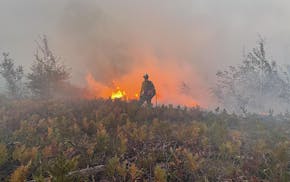Minnesota crop artists may have reason to give thanks this week.
They may owe that thanks to a century-old nonprofit that safeguards this state's crops — including the crops we glue together and display at the State Fair.
Yellow mustard seeds were a crop art staple. Plentiful, uniform in size, easy to dye, available in the grocery store spice aisle. But this year, fair officials warned, could be yellow mustard's last year.
The first rule of Minnesota crop art is that you construct your art out of Minnesota crops. There was no evidence that anyone in Minnesota was growing yellow mustard.
But before officials cut the mustard, they put the question to the Minnesota Crop Improvement Association.
In the lobby of the state's official seed certification agency hangs a framed piece of crop art: the MCIA logo, crafted out of soybeans. Everyone on staff had placed at least one soybean in the picture.
The Minnesota State Fair had come to the right place.
"Yellow mustard seed is sold as cover crop seed in Minnesota and crop producers usually use it for this purpose," said Fawad Shah, president and CEO of the association that works to ensure that if you plant an MCIA-certified seed, that seed will grow.
The Minnesota State Fair has not yet announced whether yellow mustard will make a triumphant return to the crop art gallery in 2024.
But this week — dedicated to gratitude for the abundance of our farms and fields — is as good a time as any to give thanks for people like the staff of the Minnesota Crop Improvement Association who help bring that bounty about.
The harvest is in, which means this is the busy season for the MCIA's small, dedicated staff. Thousands of bags of seed of all sorts are arriving for testing ahead of the new planting season. Oats. Ryegrass. A soybean rainbow. New varieties, bred to thrive in Minnesota's short growing season. Sturdy wheat with stalks strong enough to stand up to prairie winds.
Certification is voluntary. But farmers know that behind that seal are crops that have passed a battery of quality tests to ensure they are what they say they are and do what they say they'll do.
In laboratories on the University of Minnesota's campus, next door to the fairgrounds, trained staff test seeds for moisture, purity, and germination and ensure they're not mixed with contaminants like gravel or noxious weeds. They check established varieties, searching for signs of cross-pollination that could affect next year's crop yield.
"There's nothing flashy about our building or what we do," said Shah, whose offices are down a gravel road, tucked behind university greenhouses. MCIA built the spacious old building, then gifted it to the university. "But it's very important work that we do."
His staff studies thousands of samples for quality, looking for healthy color and uniform size. They sprout seeds in batches — under all sorts of simulated weather conditions — to make sure that at least 85% are viable.
"So much depends on a plentiful harvest," said Shah, whose staff works with companies and growers around the globe. You might find them meeting with an agricultural delegation from Zimbabwe or walking thousands of steps through farmers' fields during inspection standard tours.
They hold farmers' livelihoods in their hands, which makes it hard to believe that they found time this month to weigh in on crop art.
But there's nothing Shah and his staff like more than talking about crops and all the ways they can be improved. If you like yellow mustard, wait until you hear about the new uses Minnesotans are finding for kernza and pennycress.
"The seed is life," said Shah, jumping up like the professor he is to draw a diagram on a whiteboard in his office. The tough seed coat, encasing the endosperm that will nourish the plant embryo as it sprouts — roots spidering into the earth, shoots stretching toward the sun. Row after row, filling our fields, filling our tables this Thanksgiving week.

Brooks: Only you can prevent wildfires, Minnesota
Brooks: Minnesota state senator's burglary arrest puts private family drama in the election year spotlight
An Isanti wedding venue closed without warning. Now these couples have 'nowhere to go.'

Brooks: A tale of 124 hoarded Minnesota cats has at least a hundred happy endings


